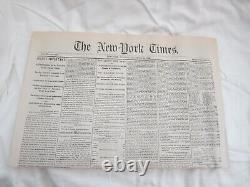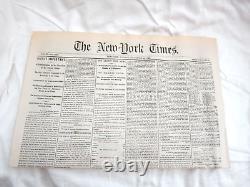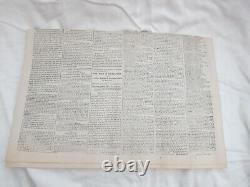
- Homepage
- Author
- Benson J. Lossing (16)
- Carl Sandburg (7)
- Edward A. Pollard (8)
- Francis T. Miller (7)
- H V Boynton (12)
- J Thomas Scharf (8)
- Jefferson Davis (12)
- Julia S. Wheelock (16)
- M W Tyler (7)
- Margaret Mitchell (19)
- Philip H. Sheridan (12)
- Rossiter Johnson (7)
- Shelby Foote (15)
- Silas Casey (9)
- Stephen Crane (10)
- U. S. Grant (11)
- U.s. Grant (11)
- U.s.grant (12)
- Ulysses S. Grant (29)
- Various (14)
- ... (4685)
- Binding
- 1 / 2 Leather (2)
- 3 / 4 Leather (2)
- Brochure / Pamphlet (4)
- Cloth (87)
- Disbound (3)
- Fine Binding (52)
- Hard Back (2)
- Hard Cover (4)
- Hardback (6)
- Hardcover (894)
- Hardcover Sheepskin (2)
- Hardcover W / Jacket (5)
- Hardcovers (2)
- Leather (259)
- Original Blue Cloth (2)
- Quarter Leather (3)
- Softcover (3)
- Softcover, Wraps (42)
- ... (3553)
- Language
- Publisher
- Bunce & Huntington (10)
- Charles L Webster (6)
- Charles L. Webster (66)
- Charles Webster (16)
- D. Appleton (11)
- D. Van Nostrand (18)
- Donohue & Henneberry (6)
- G.p. Putnam's Sons (24)
- G.p. Putnams Sons (6)
- Harper & Brothers (31)
- James G. Gregory (6)
- Johnson & Bailey (9)
- Lange & Hillman (16)
- Macmillan (14)
- Mrs. Frank Leslie (6)
- Random House (12)
- S. Mcgerald & Sons (7)
- The Century Company (17)
- Time-life Books (13)
- Unknown (6)
- ... (4627)
- Subject
- American History (7)
- Americana (79)
- Art & Photography (7)
- Bible (12)
- Children's (4)
- Civil War (60)
- Classic (4)
- Exploration & Travel (5)
- Figures & Portraits (19)
- Historic & Vintage (10)
- History (256)
- Illustrated (7)
- Literature & Fiction (37)
- Men, Civil War (8)
- Military (20)
- Military & Political (131)
- Military & War (644)
- New York (4)
- Reference (19)
- Science & Medicine (8)
- ... (3586)
- Year Printed
New York Times, September 23,1862-proclamation By The President-all Slaves Freed







NEW YORK TIMES--NEW YORK, TUESDAY, SEPTEMBER 23, 1862 - A PROCLAMATION BY THE PRESIDENT - ALL SLAVES TO BE FREED CONSISTS OF 8 PAGES, VERY CLEAN. I will weigh the book or books and give you several choices as to how you may have them sent to you. September 23, 1862: The First Emancipation Proclamation goes public. WASHINGTON (WHTM) - In September 1862, Abraham Lincoln issued the Emancipation Proclamation.
Then in January of 1863, Abraham Lincoln issued the Emancipation Proclamation. The first two years of the Civil War did not go well for the North. Though the "anaconda strategy" of blockading and slowly strangling the South was starting to gather steam, it was. Well, slow, and didn't get much attention. In the Western theater the North was making some gains (there was this guy named Grant who was showing some promise) but most eyes, both in the United State and Europe, were on the Eastern Theater. There Confederate forces, particularly the Army of Northern Virginia under Robert E. Lee, were clobbering Union forces on an embarrassingly regular basis. May 3, 1861: Winfield Scott and the Anaconda Plan. Lincoln and his cabinet not only had to worry about losing support in the North, but they also had concerns about the major powers of Europe, Britain, and France, coming in on the side of the Confederacy. They needed cotton for their textile mills, and the South was a major supplier. Lincoln wanted to declare the slaves in the South to be free, not only because it would galvanize support in the North, and make the European powers reluctant to step in on the side of the south, but because he personally loathed the peculiar institution. He had preliminary drafts of the Emancipation Proclamation in his hand and was discussing it with his cabinet. But the timing was important; if he issued it without some sort of victory in the East to back it up, it would look to many like a desperation move. Then on September 17, 1862, In the hills of western Maryland, Lincoln got what he needed. The Battle of Antietam, or Sharpsburg, was the single bloodiest day of the Civil War, with an estimated 23,000 casualties overall, and about 3,650 dead. Army War College students study history where it happened. On September 22, 1862, Lincoln signed the preliminary Emancipation Proclamation, which hit the front pages of newspapers on the 23rd. It's sort of a "one last chance before I lower the boom" document. He formally alerted the Confederacy that if they did not return to the Union he would declare all slaves within the rebellious states to be free.The Confederacy, not surprisingly, continued in rebellion, and on January 1, 1863, Lincoln issued the final Emancipation Proclamation. The two proclamations are both martial law documents; Lincoln issued them under his authority as "President of the United States of America, and Commander-in-Chief of the Army and Navy thereof". The first proclamation lists a series of Congressional acts buttressing his authority to make this proclamation and the second quotes paragraphs from the first.
The September proclamation is actually longer than the January one. BEING OFFERED BY NANNY'S CLOSET-CHECK OUT MORE GREAT DEALS ONLINE AT NANNYSCLOSETBESTDEALS.
AWESOME FOR SERIOUS COLLECTOR FOR ANY HISTORIAN!!!!! THESE ITEMS WILL MAKE GREAT GIFTS TOO.... WE ARE A FIRM BELIEVER IN THE IMPORTANCE OF FEEDBACK, THEREFORE, WE LEAVE FEEDBACK UPON RECEIPT OF YOUR FEEDBACK.
